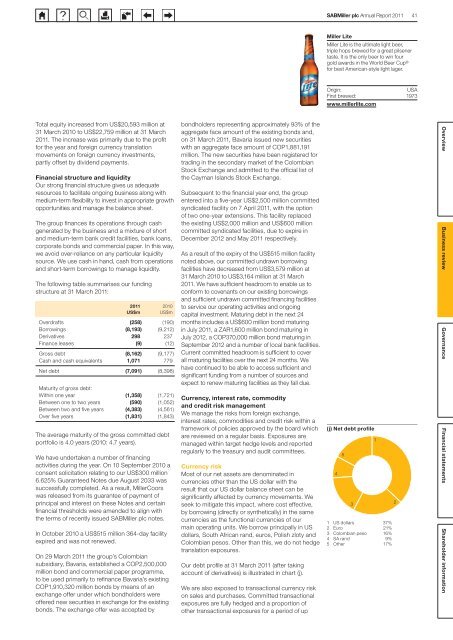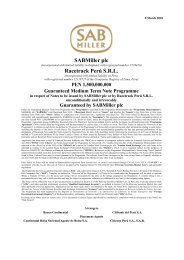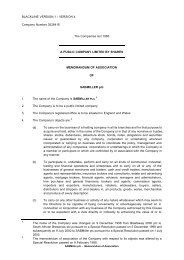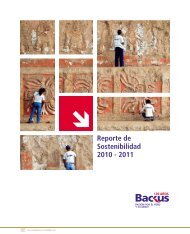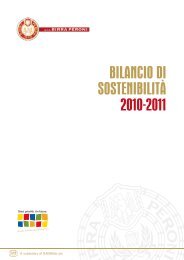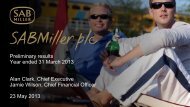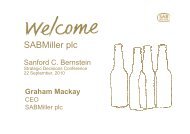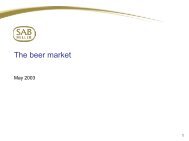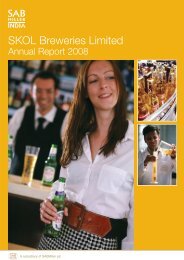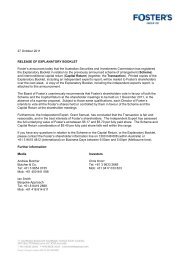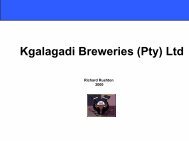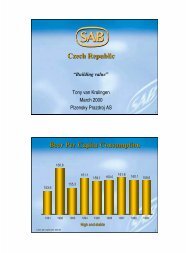Download the interactive SABMiller plc 2011 Annual report PDF
Download the interactive SABMiller plc 2011 Annual report PDF
Download the interactive SABMiller plc 2011 Annual report PDF
You also want an ePaper? Increase the reach of your titles
YUMPU automatically turns print PDFs into web optimized ePapers that Google loves.
<strong>SABMiller</strong> <strong>plc</strong> <strong>Annual</strong> Report <strong>2011</strong> 41<br />
Miller Lite<br />
Miller Lite is <strong>the</strong> ultimate light beer,<br />
triple hops brewed for a great pilsener<br />
taste. It is <strong>the</strong> only beer to win four<br />
gold awards in <strong>the</strong> World Beer Cup ®<br />
for best American-style light lager.<br />
Origin: <br />
USA<br />
First brewed: 1973<br />
www.millerlite.com<br />
Total equity increased from US$20,593 million at<br />
31 March 2010 to US$22,759 million at 31 March<br />
<strong>2011</strong>. The increase was primarily due to <strong>the</strong> profit<br />
for <strong>the</strong> year and foreign currency translation<br />
movements on foreign currency investments,<br />
partly offset by dividend payments.<br />
Financial structure and liquidity<br />
Our strong financial structure gives us adequate<br />
resources to facilitate ongoing business along with<br />
medium-term flexibility to invest in appropriate growth<br />
opportunities and manage <strong>the</strong> balance sheet.<br />
The group finances its operations through cash<br />
generated by <strong>the</strong> business and a mixture of short<br />
and medium-term bank credit facilities, bank loans,<br />
corporate bonds and commercial paper. In this way,<br />
we avoid over-reliance on any particular liquidity<br />
source. We use cash in hand, cash from operations<br />
and short-term borrowings to manage liquidity.<br />
The following table summarises our funding<br />
structure at 31 March <strong>2011</strong>:<br />
<strong>2011</strong><br />
US$m<br />
2010<br />
US$m<br />
Overdrafts (258) (190)<br />
Borrowings (8,193) (9,212)<br />
Derivatives 298 237<br />
Finance leases (9) (12)<br />
Gross debt (8,162) (9,177)<br />
Cash and cash equivalents 1,071 779<br />
Net debt (7,091) (8,398)<br />
Maturity of gross debt:<br />
Within one year (1,358) (1,721)<br />
Between one to two years (590) (1,052)<br />
Between two and five years (4,383) (4,561)<br />
Over five years (1,831) (1,843)<br />
The average maturity of <strong>the</strong> gross committed debt<br />
portfolio is 4.0 years (2010: 4.7 years).<br />
We have undertaken a number of financing<br />
activities during <strong>the</strong> year. On 10 September 2010 a<br />
consent solicitation relating to our US$300 million<br />
6.625% Guaranteed Notes due August 2033 was<br />
successfully completed. As a result, MillerCoors<br />
was released from its guarantee of payment of<br />
principal and interest on <strong>the</strong>se Notes and certain<br />
financial thresholds were amended to align with<br />
<strong>the</strong> terms of recently issued <strong>SABMiller</strong> <strong>plc</strong> notes.<br />
In October 2010 a US$515 million 364-day facility<br />
expired and was not renewed.<br />
On 29 March <strong>2011</strong> <strong>the</strong> group’s Colombian<br />
subsidiary, Bavaria, established a COP2,500,000<br />
million bond and commercial paper programme,<br />
to be used primarily to refinance Bavaria’s existing<br />
COP1,910,320 million bonds by means of an<br />
exchange offer under which bondholders were<br />
offered new securities in exchange for <strong>the</strong> existing<br />
bonds. The exchange offer was accepted by<br />
bondholders representing approximately 93% of <strong>the</strong><br />
aggregate face amount of <strong>the</strong> existing bonds and,<br />
on 31 March <strong>2011</strong>, Bavaria issued new securities<br />
with an aggregate face amount of COP1,881,191<br />
million. The new securities have been registered for<br />
trading in <strong>the</strong> secondary market of <strong>the</strong> Colombian<br />
Stock Exchange and admitted to <strong>the</strong> official list of<br />
<strong>the</strong> Cayman Islands Stock Exchange.<br />
Subsequent to <strong>the</strong> financial year end, <strong>the</strong> group<br />
entered into a five-year US$2,500 million committed<br />
syndicated facility on 7 April <strong>2011</strong>, with <strong>the</strong> option<br />
of two one-year extensions. This facility replaced<br />
<strong>the</strong> existing US$2,000 million and US$600 million<br />
committed syndicated facilities, due to expire in<br />
December 2012 and May <strong>2011</strong> respectively.<br />
As a result of <strong>the</strong> expiry of <strong>the</strong> US$515 million facility<br />
noted above, our committed undrawn borrowing<br />
facilities have decreased from US$3,579 million at<br />
31 March 2010 to US$3,164 million at 31 March<br />
<strong>2011</strong>. We have sufficient headroom to enable us to<br />
conform to covenants on our existing borrowings<br />
and sufficient undrawn committed financing facilities<br />
to service our operating activities and ongoing<br />
capital investment. Maturing debt in <strong>the</strong> next 24<br />
months includes a US$600 million bond maturing<br />
in July <strong>2011</strong>, a ZAR1,600 million bond maturing in<br />
July 2012, a COP370,000 million bond maturing in<br />
September 2012 and a number of local bank facilities.<br />
Current committed headroom is sufficient to cover<br />
all maturing facilities over <strong>the</strong> next 24 months. We<br />
have continued to be able to access sufficient and<br />
significant funding from a number of sources and<br />
expect to renew maturing facilities as <strong>the</strong>y fall due.<br />
Currency, interest rate, commodity<br />
and credit risk management<br />
We manage <strong>the</strong> risks from foreign exchange,<br />
interest rates, commodities and credit risk within a<br />
framework of policies approved by <strong>the</strong> board which<br />
are reviewed on a regular basis. Exposures are<br />
managed within target hedge levels and <strong>report</strong>ed<br />
regularly to <strong>the</strong> treasury and audit committees.<br />
Currency risk<br />
Most of our net assets are denominated in<br />
currencies o<strong>the</strong>r than <strong>the</strong> US dollar with <strong>the</strong><br />
result that our US dollar balance sheet can be<br />
significantly affected by currency movements. We<br />
seek to mitigate this impact, where cost effective,<br />
by borrowing (directly or syn<strong>the</strong>tically) in <strong>the</strong> same<br />
currencies as <strong>the</strong> functional currencies of our<br />
main operating units. We borrow principally in US<br />
dollars, South African rand, euros, Polish zloty and<br />
Colombian pesos. O<strong>the</strong>r than this, we do not hedge<br />
translation exposures.<br />
Our debt profile at 31 March <strong>2011</strong> (after taking<br />
account of derivatives) is illustrated in chart (j).<br />
We are also exposed to transactional currency risk<br />
on sales and purchases. Committed transactional<br />
exposures are fully hedged and a proportion of<br />
o<strong>the</strong>r transactional exposures for a period of up<br />
(j) Net debt profile<br />
4<br />
5<br />
3<br />
1 US dollars 37%<br />
2 Euro 21%<br />
3 Colombian peso 16%<br />
4 SA rand 9%<br />
5 O<strong>the</strong>r 17%<br />
1<br />
2<br />
Overview Business review Governance Financial statements Shareholder information


